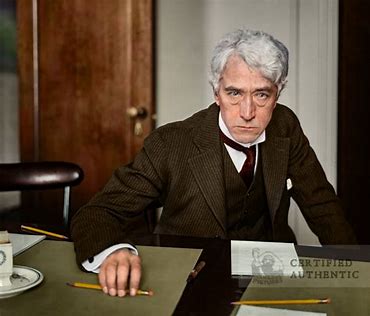My proposed Hall of Shame, within the Hall of Fame, would be like purgatory, waiting to get into Heaven as the case is debated. Baseball Commissioners have proven to be stubborn with their decisions. However, future circumstances might dictate these fallen player’s eligibility back in baseball, just as the Armando Gallarraga 28-out game (ruled out of a perfect game on the last out) eventually spurred the addition of replay and continues to be discussed. It opened eyes! Who knows, maybe a future commissioner will see the difference between good players and bad actions?
There were several “bad” players unofficially banned from baseball before the creation of the office of Commissioner of Baseball in 1921. They later had their bans made “official” by baseball’s first Commissioner, Kenesaw Mountain Landis, who made it clear that gambling would not be tolerated. Landis barred a total of nineteen people during his tenure, five more than all of his successors combined. Of the nineteen, two were re-instated by Landis, one was re-instated by a successor and sixteen remain banned.
Long before Landis came to power and dating back to 1865, Thomas Devyr, Ed Duffy, and William Wansley of the New York Mutuals were banned for associating with known gamblers. John Radcliff of the Chicago White Stockings was banned in 1874 after attempting to bribe an umpire. The White Stockings, predecessors of the Cubs, were prohibited from using “Chicago” as part of their name beginning in 1900. The city of Chicago was soon to become the poster child for bad behavior in baseball.
All of these early players were eventually reinstated. George Bechtel of the National League Louisville Grays was banned in 1876 for conspiring to intentionally lose a game and never reinstated. His teammates, Jim Devlin, George Hall, Al Nichols, and Bill Craver followed in 1877 and were also never reinstated. Fellow NL competitor Lip Pike of Worchester arose suspicions for his play in 1881, and was banned, blacklisted, then finally reinstated in 1883.
As for non-players before the Landis regime, bans were issued to umpire Dick Higham in 1882 for conspiracy, New York Giants team physician Joseph Marie Creamer, III for bribery, St. Louis Browns managers Jack O’Connor and Henry Howell for attempting to fix the outcome of the 1910 American League batting title, and the 1912 Philadelphia Phillies owner, Horace Fogel for asserting that umpires were making unfair calls against his team. The are no records of reinstatement for any of these men.
Henry Zimmerman, also known as “Heinie” or “The Great Zim” was another famous case. He played third base for the Chicago Cubs and New York Giants, winning the National League triple crown in 1912. He was banned for fixing games with suspicion arising after his poor performance in the 1917 World Series. This was two years before the Black Sox scandal, but it took another two years for it to become official by Landis in 1921, following the trial testimony of his manager John Mcgraw, who was reluctant to turn him in.
Joe “Moon” Harris of the Cleveland Indians was banned in 1920 when he chose to play for an independent team rather than the Indians, violating the reserve clause. This proved to be simply breaking the rules but not the law, and he was justifiably reinstated by Commissioner Landis in 1922, in part for his service during WW II. Another non-gambling related ban occurred back in 1877, when Oscar Walker was accused of “contract jumping” by signing to play for another team while still under contract to the team he left. This was 98-years prior to free agency, another example of how time changes the rules.
The following year, Hal Chase of the New York Giants was banned for gambling with accusations extending back to 1910. This indiscretion also cost him a managerial position. He was also suspended in 1918 by Reds manager Christy Mathewson for fixing games and traded to the Giants. By the end of the 1919 season, NL president John Heydler disclosed evidence of Chase bribing players on other teams and had him blackballed, so neither league would touch him. 1921 was a bad year to face Commissioner Landis. Joe Gedeon of the St. Louis Browns, and Eugene Paulette of the Philadelphia Phillies, Lee Magee of the Chicago Cubs were all banned for conspiring or associating with known gamblers. Heinie Groh of the Cincinnati Reds was banned for two-days before agreeing contract salary terms. Play or face lifetime banishment was Landis’ ultimatum. On the criminal side, Bennie Kauff of the New York Giants was banned for selling stolen cars. Even though he was acquitted, the Judge considered him “no longer a fit companion for other ball players.” Ray Fisher of the Reds violated his contract by accepting a coaching position at the University of Michigan, Landis ruled. Bowie Kuhn reversed this decision in 1980, following the death of Landis.
In 1922, Dickie Kerr of the White Sox, one of the “Clean Sox,” was banned for violating the reserve clause in his contract and was reinstated three-years later. Also, Phil Douglas of the New York Giants received a Landis ban for allegedly threatening to “jump” the team for the pennant stretch to spite coach McGraw. Judge Landis was obviously a no-nonsense strict ruler, and players began to fall in line after his first year in office.
1923 was quiet but in 1924, Jimmy O’Connell of the New York Giants and his coach, Cozy Dolan, were both banned for bribing a Phillies shortstop. William D. Cox, the owner of the Phillies, was the last living person banned by Landis in 1943 for betting. Landis seemed to feast on Philly owners.
In his most celebrated case, Judge Landis officially went to work on the eight players of the Chicago White Sox. All were banned in 1921 for conspiring with gamblers to throw the 1919 World Series, known as the Black Sox scandal. We’ll get into that in the next installment.

Leave a Reply